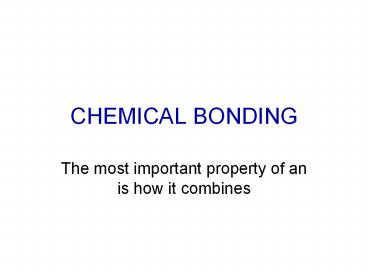CHEMICAL BONDING PowerPoint PPT Presentation
Title: CHEMICAL BONDING
1
CHEMICAL BONDING
- The most important property of an is how it
combines
2
Outcomes/Objectives Things you will be able to do
- Define chemical bond and relate to valence
electrons - Predict an elements chemical properties using the
number of valence electrons. - Draw Bohr models and electron dot diagrams for
elements. - List three types of bonding
- Describe how an Ionic Bond forms and the force
that keeps them together. - Define Ion
- QUIZ
- Describe how a covalent bond forms.
- Define Molecule
- Recognize and describe polyatomic ions.
- Test Preparation
- Study Daily, Complete All Assignments ,Stay 10th
, Stay on Task (Focus),
PLEASE ask for HELP when LOST
3
Chemical Bond
- Attractive force that holds or
together - Atoms of different Elements can combine with each
other in many different ways - Example
4
ELECTRONS AND BONDING
- e- are arranged into
- Energy Levels can hold more e- as you move
farther away from the nucleus via (2level2)
- For bonding reasons in general atoms will form
compounds if the bonding results in both Atoms - The of valence e- determines an elements
5
- Electron Dot Diagrams of Elements only show the
symbol surrounded by dots that represent the of
valence electrons. Create e- dot diagrams for
elements 3 to 10.
- Make Bohr Models of Elements 3 Through 10
6
CHEMICAL BONDING AND STABILITY
- Atoms want to have stable electron
configurations. And in order to be stable they
need in their outer energy level. This can
be achieved by bonding with other atoms. - transfer of electrons from atom to atom
- sharing of electrons
- the attraction between a metal cation and
the shared electrons that surround it
7
Ionic Bonds Transfer of e-
- Atoms can
in their outer level (shell) - Form between
- Stay together because of an
between oppositely charged
8
IONS
- METALS
- tend to
- form
- than the atoms that make them up
b/c the nucleus
- NONMETALS
- tend to
- form
- than the atoms that make them up b/c
the nucleus
9
COVALENT BONDING
- Sharing
- Form between.
- Form
- Can be
- More
10
COVALENTLY BONDED IONS
- _________________
- a group of covalently bonded atoms that has an
electric charge due to - Example
- Metallic Bonds
PowerShow.com is a leading presentation sharing website. It has millions of presentations already uploaded and available with 1,000s more being uploaded by its users every day. Whatever your area of interest, here you’ll be able to find and view presentations you’ll love and possibly download. And, best of all, it is completely free and easy to use.
You might even have a presentation you’d like to share with others. If so, just upload it to PowerShow.com. We’ll convert it to an HTML5 slideshow that includes all the media types you’ve already added: audio, video, music, pictures, animations and transition effects. Then you can share it with your target audience as well as PowerShow.com’s millions of monthly visitors. And, again, it’s all free.
About the Developers
PowerShow.com is brought to you by CrystalGraphics, the award-winning developer and market-leading publisher of rich-media enhancement products for presentations. Our product offerings include millions of PowerPoint templates, diagrams, animated 3D characters and more.

